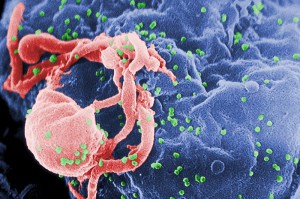Saturday 1st December is World AIDS Day. World Aids Day was the first global health awareness day held in 1988 to help commemorate those who have died of AIDS, raise awareness of the disease, and help drive support for people living with HIV. 25 years on, this year the WHO has defined this year as World AIDS Day 2012: Getting to Zero.
 100,000 people are currently living with HIV in the UK alone – worldwide this number is estimated to be 34 million which includes 3.3 million children. Each day almost 7,000 are people newly infected and although antiretroviral therapy is increasingly allowing people to lead normal lives 1.7 million people died of AIDS in 2011.
100,000 people are currently living with HIV in the UK alone – worldwide this number is estimated to be 34 million which includes 3.3 million children. Each day almost 7,000 are people newly infected and although antiretroviral therapy is increasingly allowing people to lead normal lives 1.7 million people died of AIDS in 2011.
The Terrance Higgins Trust, set up 30 years ago, aims to maximize good sexual health in the UK, and minimize the spread of HIV and other STIs as well as providing support and campaigning to eradicate stigma and discrimination still prevalent. Organizations like the HIV Research Trust aim to provide scholarships to physicians, nurses, scientists working with HIV. The red ribbon symbolizes hope and a positive future in preventing and treating HIV.
In the last few days alone research published in BioMed Central’s journals is helping understand the biology behind HIV infection, issues arising from living with infection, and global impact of treatment programs.
People with HIV require more care during surgery
Effective antiviral therapy means that people with HIV are living a more normal lifespan and consequently suffer the same health problems as the rest of the population. However new research published in AIDS Research and Therapy finds that patients undergoing surgery who also have HIV are more likely to get nosocomial infections while in hospital, and would benefit from prophylactic antibiotics.
LRRK2 inhibition may provide respite from HIV-1 associated neurocognitive disorders
HIV-1 invades the central nervous system (CNS) early after infection and, despite combined antiretroviral therapy, HIV-1 associated neurocognitive disorders (HANDs) remain a serious problem. A study in Journal of Neuroinflammation suggests that leucine-rich repeat kinase 2 (LRRK2), known to be a key player in microglia inflammation, is involved in HANDs, and that LRRK2 kinase inhibition is able to ‘protect’ microglia cells in the lab. While further research is needed LRRK2 kinase inhibition may prove an effective therapeutic strategy for HANDs.
The secrets of miRNA in HIV-associated dementia
HIV-associated dementia (HAD) is the most common type of dementia type in young adults under 40 years old. miRNA, a class of small, non-coding, regulatory RNAs, are known to be involved in HIV-host interaction. An article in BMC Genomics compares mRNA and miRNA profiles of the frontal cortex from HIV positive patients with and without dementia. From this researchers have found that 68 miRNA were differentially expressed in HAD and correlated with mRNA targets involved in neuronal cell maintenance and function.
“The problem is ours, it is not CRAIDS”
HIV and AIDS are a world problem. A case study in Globalization and Health looking at how a global program, the World Bank Multi-Country AIDS Program (MAP) and in particular the Community Response to AIDS (CRAIDS), contributed to the sustainability of CBOs in Zambia, finds that a lack of infrastructure and training resulted in a loss of services. Instead the authors propose a set of principles based on the needs, contexts and experiences of the individuals and families within each community, rather than a single model or formula, which are needed to ensure the sustainability of CBO HIV programs.
Comments